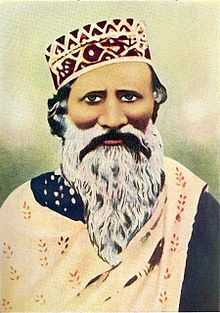Radha Soami
| Radha Soami | |
|---|---|
 Radha soami Satsang | |
| Motto | To experience the divinity of God who resides in all of us. To realize the truth of the concept that there is only one God and we are all expressions of his love. |
| Formation | 1861 |
| Region served | Worldwide |
| Membership | 3,000,000[1] |
| Official languages | Hindi, Punjabi |
| Main organ | Radhasoami Satsang |
Radhasoami (Radha Swami) is a spiritual movement that originated in 19th century India, and is considered by adherents as a true way to attain God realization. The Radhasoami faith is also referred to as Sant Mat, the "Path of the Sants." The word "Radhasoami" itself is actually a combination of two words: "Radha" (referring to the soul or spiritual essence, either of an individual or of the whole) and "Soami" (referring to the spiritual master; cognate to the Sanskrit term swami or svami); the combined word thus refers to the "Lord of the Soul" or God. It also can be interpreted to mean the "Master Soul" or "Spirit Master" who guides the disciple to higher states of consciousness. Like Sant Mat sects, Radhasoami emphasizes the use of listening to inner sound accessed by (mantra/simran), combined with personal loyalty to a given living Master, for devotees to attain desired states of spiritual advancement.
Shiv Dayal Singh, called "Soamiji Maharaj" by devotees and admirers, was a khatri seth by caste in Agra, India. He used to insist that anyone who chose to follow him must give up non-vegetarian food, abstain from alcohol and intoxicants, lead a high moral life and engage in over two hours of shabd yoga (sound-current yoga) meditation per day.[2]
In the mid-1850s, Shiv Dayal Singh had a handful of followers in Agra. However, his teachings eventually attracted disciples from across India and by the time of his death in 1878, Shiv Dayal had several thousands of followers. He died on 15 June 1878 in Agra, India.
Shiv Dayal Singh's wife, Narayani Devi (called Radhaji), Rai Saligram (called Huzur Maharaj), Sanmukh Das, Gharib Das, Partap Singh (Shiv Dayal's younger brother) and Baba Jaimal Singh were some of his prominent followers around whom individual satsang groups formed. This splintering off, led to the propagation of Radhasoami teachings to a wider audience, although with slightly varied interpretations.
Spiritual Meditation
Radhasoami teachings center upon a type of meditation practice known as surat shabd yoga. Shabd is referring to a spiritual current which can be perceived in meditation as inner light and sound. Yoga is referring to the uniting of our real essence (soul) through an inner listening with focused mental concentration (surat) upon an inner sound (shabd) which it is maintained emanates from Radhasoami the Supreme Being. It is therefore taught as the unchanging and primordial technique for uniting the soul with the supreme being via the power of Shabd.
Following the practice of meditation under the guidance of a spiritual teacher who is himself in contact with Shabd, is considered of paramount importance.
Pre-requisites for successful achievement of the meditation practice are a lacto-vegetarian diet, abstaining from drugs and alcohol, and maintaining a pure and moral lifestyle.
Radha Soami Satsang Beas lineage
The Beas Satsang was founded by Shivdayal Singh's disciple Jaimal Singh. The Beas lineage is:
- Jaimal Singh - Master, 1884-1903.
- Baba Sawan Singh - Master, 1903-1948.
- Jagat Singh - Master, 1948-1951.
- Charan Singh - Master, 1951-1990.
- Gurinder Singh - Master, 1990–present.
At the core of the RSSB philosophy is a belief that there is a spiritual purpose to human life – to experience the divinity of God who resides in all of us. It is through this experience that we will realize the truth of the concept that there is only one God and we are all expressions of his love.[2] Central to the RSSB philosophy is a living spiritual teacher who explains the purpose of life and guides and instructs members in a method of spirituality based on a daily meditation practice. The present teacher Gurinder Singh Dhillon lives with his family at the main centre in Beas.
See also
- Contemporary Sant Mat movement
- Radha Swami Satsang, Dinod
- Dayalbagh
- Bhagat Munshi Ram
References
- ↑ Peter Bernard Clarke (2006). Encyclopedia Of New Religious Movements. Psychology Press.
- ↑ 2.0 2.1 "Introduction to the Radha Swami faith". Radha Swami Dera Baba Bagga Singh. Radha Swami Dera Baba Bagga Singh. Retrieved 25 June 2012.
- ^ Larson, Gerald J. India's Agony Over Religion (1995). p. 136. SUNY Press (State University of New York) ISBN 0-7914-2411-1
Further reading
- Juergensmeyer, Mark (1991). Radhasoami Reality: The Logic of a Modern Faith, Princeton, New Jersey: Princeton University Press. ISBN 0-691-07378-3
- Lane, David C (1992). The Radhasoami Tradition, New York. Garland Publishing. ISBN 978-0-8240-5247-8
- Schomer, Karine & William Hewat McLeod, eds (1987).The Sants: Studies in a Devotional Tradition of India, Delhi: Motilal Banarsidass, 1987. Academic papers from a 1978 Berkeley conference on the Sants organised by the Graduate Theological Union and the University of California Center for South Asia Studies. ISBN 81-208-0277-2
External links
- RSSB Beas
- RadhaSoami
- Online Radhasoami Books, Soami Bagh E-Library, English Book Index
- Radhasoami Satsang Soami Bagh, Agra